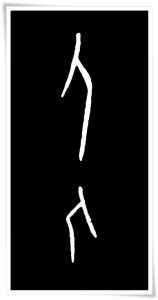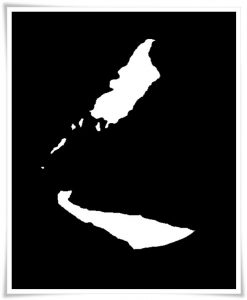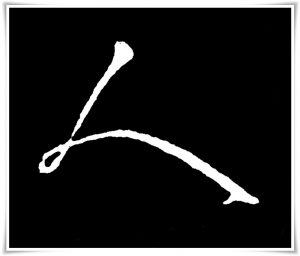
1. Meaning:
person
2. Readings:
- Kunyomi (訓読み): と, ひと, -り
- Onyomi (音読み): ジン, ニン
- Japanese names: じ, と, ね, ひこ, ふみ, ニン
- Chinese reading: rén
3. Etymology
人 belongs to the 象形文字 (しょうけいもじ, shōkeimoji, i.e., set of characters of pictographic origin). It is a pictograph of the left-hand side profile of a standing person.

According to the 說文解字 (pinyin: shūowén jiězì, i.e. “Explaining Simple [Characters] and Analyzing Compound Characters”) from the 2nd century C.E., compiled by a philologist of the Han dynasty (漢朝, pinyin: Hàn Cháo, 206 B.C. – 220 C.E.), Shu shen (許慎, pinyin: Xǔ Shèn, ca. 58 C.E. – ca. 147 C.E.), the meaning of the character 人 was associated with the virtues of Heaven and Earth (i.e. the universe).
Eight hundred years later this ideology was further explained by the neo-Confucian philosopher Zhang Zai (張載; pinyin: Zhāng Zǎi, 1020–1077 C.E.). A synopsis of his belief is that the purification of one’s character (self-improvement) returns it to its natural primordial state, harmonious with that of the Universe itself.

Kinbun (金文, きんぶん, i.e. “text on metal”) and divinatory script forms (卜文, ぼくぶん, bokubun) are consistent with the later great seal script forms (so called 籀文, ちゅうぶん, i.e. “great seal script form beginning from the Spring and Autumn period”), and suggest that the shape of the character 人 emphasises two parts of the human body, the elbow and the shin. Additionally, the entire posture of the body is curved (in some forms it even seems to be cringed), further emphasised by the bent back and knees.
This theory finds its confirmation in characters such as 見 (けん, ken, i.e. “to see”), where the lower radical (儿, がい, i.e. “legs radical”) symbolised the bent figure of a human being. Note that the meaning of 儿 in the modern character 見 (printed form) is not the same as the meaning of the modern radical 儿. According to the commentaries to “Explaining Simple (Characters) and Analyzing Compound Characters” written by Duan Yucai (段玉裁, pinyin: Duàn Yùcái, 1735 – 1815), the radical 儿 was a pictograph of a bent figure of a person, symbolising benevolence. Refer to the article regarding the etymology of the character 見 to learn more.

4. Selected historical forms of 人.
Figure 1. Oracle bone script (甲骨文, こうこつぶん, kōkotsubun) forms of 人, Shang dynasty (商朝, pinyin: Shāng Cháo, 1600 B.C. – 1046 B.C.).
Figure 2. Ink rubbing of small seal script (小篆, しょうてん, shōten) of the character 人 from a calligraphy work by Deng Wanbai (鄧完白, pinyin: Dèng Wángbái, 1743 – 1805), Qing dynasty (清朝, pinyin: Qīng Cháo, 1644 – 1912 C.E.).
Figure 3. Ink rubbing of the clerical script (隷書, れいしょ, reisho) form of the character 人, found on the stele 曹全碑 (pinyin: Cáo quán bēi), Han dynasty (漢朝, pinyin: Hàn Cháo, 206 B.C. – 220 C.E.), 185 C.E.

Figure 4. Cursive script (草書, そうしょ, sōsho) form of the character 人 from the calligraphy work entitled “Poems of Li Jiao” (李嶠詩, pinyin: Lǐ Jiào shī) by the 52nd emperor of Japan, Emperor Saga (嵯峨天皇, さがてんのう, Saga Tennō, 785–842). Lǐ Jiào was a famous Tang dynastyTang dynasty (唐朝, pinyin: Táng Cháo, 618 – 907 C.E.) poet.
Figure 5. Ink rubbing of the character 人 in standard script (楷書, かいしょ, kaisho), reproduced from the stele in the Mausoleum of Confucius (孔子廟堂碑, pinyin: Kǒngzǐ miàotáng bēi), 7th century C.E.
Figure 6. Semi-cursive script (行書, ぎょうしょ, gyōsho) form of the character 人, found in the calligraphy work entitled 澄清堂帖 (pinyin: Chéngqīng tángtiē) attributed to Wang Xizhi (王羲之, pinyin: Wáng Xīzhī, 303 – 361), often referred to as the Sage of Calligraphy (書聖; pinyin: shūshèng), Jin Dynasty (晉朝, pinyin: Jìn Cháo, 265 – 420 C.E.). The original work did not survive (in fact, none of his original works exist), and the rubbing was taken from a stele erected during the Ming dynasty (明朝, pinyin: Míng Cháo, 1368 – 1644 C.E.).

5. Useful phrases
- 人間 (にんげん, ningen) – human being
- 大人 (おとな, otona) – an adult
- 人口 (じんこう, jinkō) – population
- 人生 (じんせい, jinsei) – life
- 人形 (にんぎょう, ningyō) – a doll
Text: Ponte Ryūrui (品天龍涙)
English editing: Rona Conti
Japanese/Chinese editing: Yuki Mori (森由季)
